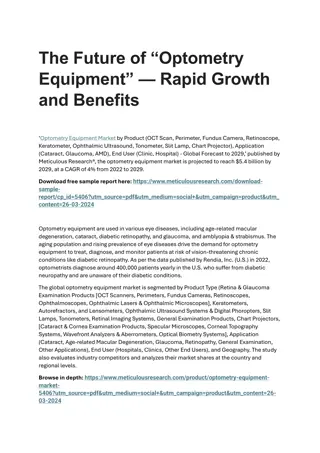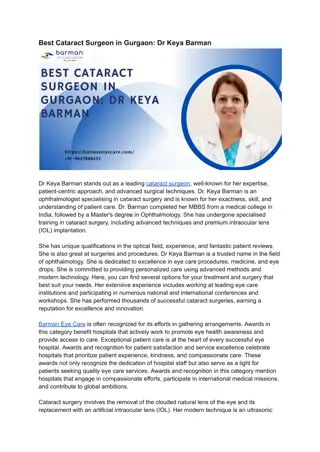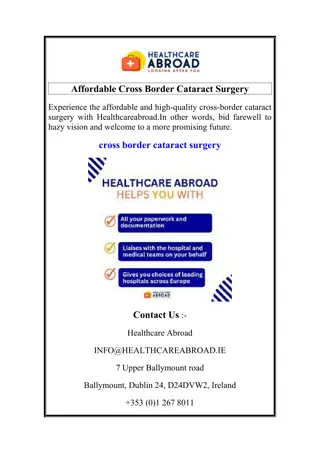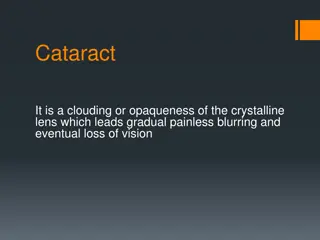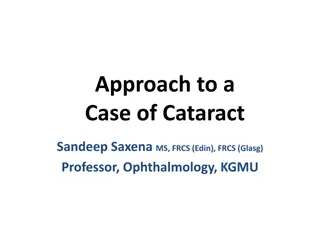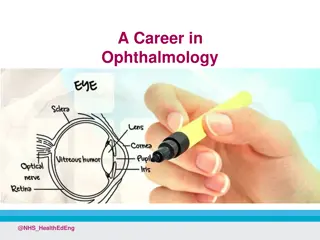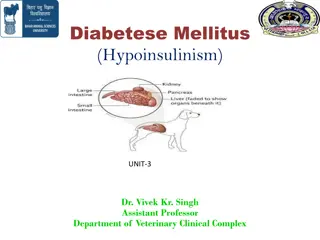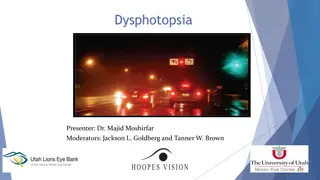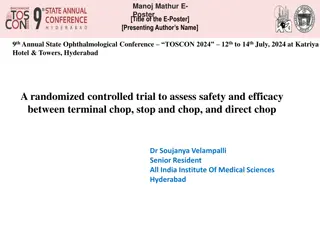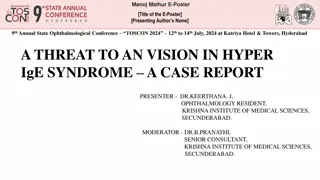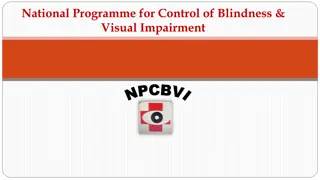
Cataracts: Types, Symptoms, and Treatment Options
Learn about different types of cataracts, their symptoms, causes, diagnosis, treatment, and prevention methods. Explore how cataracts can affect your vision and when surgery may be necessary for better eyesight.
Download Presentation

Please find below an Image/Link to download the presentation.
The content on the website is provided AS IS for your information and personal use only. It may not be sold, licensed, or shared on other websites without obtaining consent from the author. If you encounter any issues during the download, it is possible that the publisher has removed the file from their server.
You are allowed to download the files provided on this website for personal or commercial use, subject to the condition that they are used lawfully. All files are the property of their respective owners.
The content on the website is provided AS IS for your information and personal use only. It may not be sold, licensed, or shared on other websites without obtaining consent from the author.
E N D
Presentation Transcript
StudyMafia.Org Cataract Submitted To: Studymafia.org Studymafia.org Submitted By:
Table Contents Definition Introduction Types of Cataract Symptoms of Cataract Causes of Cataract Risk-Factors of Cataract Diagnosis of Cataract Treatment of Cataract Prevention of Cataract Conclusion 2
Definition A cataract is a clouding of the normally clear lens of the eye. For people who have cataracts, seeing through cloudy lenses is a bit like looking through a frosty or fogged-up window 3
Introduction Clouded vision caused by cataracts can make it more difficult to read, drive a car (especially at night) or see the expression on a friend's face. Most cataracts develop slowly and don't disturb your eyesight early on. But with time, cataracts will eventually interfere with your vision. At first, stronger lighting and eyeglasses can help you deal with cataracts. But if impaired vision interferes with your usual activities, you might need cataract surgery. 4
Types of Cataract Cataracts affecting the center of the lens (nuclear cataracts). A nuclear cataract may at first cause more nearsightedness or even a temporary improvement in your reading vision. But with time, the lens gradually turns more densely yellow and further clouds your vision. As the cataract slowly progresses, the lens may even turn brown. Advanced yellowing or browning of the lens can lead to difficulty distinguishing between shades of color. 5
Types of Cataract Cataracts that affect the edges of the lens (cortical cataracts). A cortical cataract begins as whitish, wedge- shaped opacities or streaks on the outer edge of the lens cortex. As it slowly progresses, the streaks extend to the center and interfere with light passing through the center of the lens. Cataracts that affect the back of the lens (posterior subcapsular cataracts). A posterior subcapsular cataract starts as a small, opaque area that usually forms near the back of the lens, right in the path of light. 6
Types of Cataract Cataracts you're born with (congenital cataracts). Some people are born with cataracts or develop them during childhood. These cataracts may be genetic, or associated with an intrauterine infection or trauma. These cataracts may also be due to certain conditions, such as myotonic dystrophy, galactosemia, neurofibromatosis type 2 or rubella. Congenital cataracts don't always affect vision, but if they do, they're usually removed soon after detection. 7
Causes of Cataract Most cataracts develop when aging or injury changes the tissue that makes up the eye's lens. Proteins and fibers in the lens begin to break down, causing vision to become hazy or cloudy. Some inherited genetic disorders that cause other health problems can increase your risk of cataracts. Cataracts can also be caused by other eye conditions, past eye surgery or medical conditions such as diabetes. Long-term use of steroid medications, too, can cause cataracts to develop. 9
Causes of Cataract A cataract is a cloudy lens. The lens is positioned behind the colored part of your eye (iris). The lens focuses light that passes into your eye, producing clear, sharp images on the retina the light-sensitive membrane in the eye that functions like the film in a camera. As you age, the lenses in your eyes become less flexible, less transparent and thicker. Age-related and other medical conditions cause proteins and fibers within the lenses to break down and clump together, clouding the lenses. 10
Risk factors of Cataract Increasing age Diabetes Excessive exposure to sunlight Smoking Obesity High blood pressure Previous eye injury or inflammation Previous eye surgery Prolonged use of corticosteroid medications Drinking excessive amounts of alcohol 11
Diagnosis of Cataract Visual acuity test. A visual acuity test uses an eye chart to measure how well you can read a series of letters. Slit-lamp examination. A slit lamp allows your eye doctor to see the structures at the front of your eye under magnification. Retinal exam. To prepare for a retinal exam, your eye doctor puts drops in your eyes to open your pupils wide (dilate). Applanation tonometry. This test measures fluid pressure in your eye. There are multiple different devices available to do this. 12
Treatment of Cataract Cataract surgery involves removing the clouded lens and replacing it with a clear artificial lens. The artificial lens, called an intraocular lens, is positioned in the same place as your natural lens. It remains a permanent part of your eye. For some people, other eye problems prohibit the use of an artificial lens. In these situations, once the cataract is removed, vision may be corrected with eyeglasses or contact lenses. 13
Treatment of Cataract Cataract surgery is generally done on an outpatient basis, which means you won't need to stay in a hospital after the surgery. During cataract surgery, your eye doctor uses a local anesthetic to numb the area around your eye, but you usually stay awake during the procedure. Cataract surgery is generally safe, but it carries a risk of infection and bleeding. Cataract surgery increases the risk of retinal detachment. 14
Prevention of Cataract Have regular eye examinations. Eye examinations can help detect cataracts and other eye problems at their earliest stages. Ask your doctor how often you should have an eye examination. Quit smoking. Ask your doctor for suggestions about how to stop smoking. Medications, counseling and other strategies are available to help you. Manage other health problems. Follow your treatment plan if you have diabetes or other medical conditions that can increase your risk of cataracts. 15
Prevention of Cataract Choose a healthy diet that includes plenty of fruits and vegetables. Adding a variety of colorful fruits and vegetables to your diet ensures that you're getting many vitamins and nutrients. Fruits and vegetables have many antioxidants, which help maintain the health of your eyes. Wear sunglasses. Ultraviolet light from the sun may contribute to the development of cataracts. Wear sunglasses that block ultraviolet B (UVB) rays when you're outdoors. Reduce alcohol use. Excessive alcohol use can increase the risk of cataracts. 16
Conclusion Cataract surgery is a procedure to remove the lens of your eye and, in most cases, replace it with an artificial lens. Normally, the lens of your eye is clear. A cataract causes the lens to become cloudy, which eventually affects your vision. 18
References Google.com Wikipedia.org Studymafia.org Slidespanda.com
Thanks To StudyMafia.org


